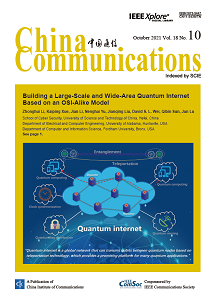NGSO宽带卫星通信系统中基于分组的PNT业务性能分析
IF 3.1
3区 计算机科学
Q2 TELECOMMUNICATIONS
引用次数: 0
摘要
为gnss挑战用户提供替代PNT服务将是下一代NGSO宽带卫星通信系统的一项重要功能。本文提出了一种基于分组的NGSO宽带系统PNT业务架构,该架构由主卫星和选定的辅助卫星共同向请求用户提供PNT服务。通过对不同波形约束边界的严格分析,建立了定位性能边界的数学公式。对Walker Delta MEO星座和Walker Star LEO星座的不同配置进行了仿真验证,结果表明:(1)在卫星数量足够的情况下,MEO和LEO星座的定位精度都达到了亚米级。(2)与基于GNSS多普勒的速度估计方法相比,基于位置推进的速度估计算法精度更高,适用于NGSO宽带系统中的PNT业务。(3)为了向gnss挑战环境中的用户提供PNT服务,主卫星和每个辅助卫星只需要一个下行波束的~ 0.1%的时间。本文章由计算机程序翻译,如有差异,请以英文原文为准。
Performance analysis of the packet-based PNT service in NGSO broadband satellite communication systems
Providing alternative PNT service to GNSS-challenged users will be an important function of next-generation NGSO broadband satellite communication systems. Herein, a packet-based PNT service architecture in NGSO broadband systems is proposed in which a primary satellite and selected assistant satellites work together to provide PNT service to requesting users. Its positioning performance bounds are mathematically formulated by rigorously analyzing the bounds constrained by different waveforms. Simulations are conducted on different configurations of Walker Delta MEO constellations and Walker Star LEO constellations for corroboration, revealing the following: (1) Both MEO and LEO constellations achieve sub-meter-level positioning precision given enough satellites. (2) Compared to the GNSS Doppler-based velocity estimation method, the position advance based velocity estimation algorithm is more precise and applicable to the PNT service in NGSO broadband systems. (3) To provide PNT service to users in GNSS-challenged environments, the primary and each assistant satellite need only ∼0.1%o of the time of one downlink beam.
求助全文
通过发布文献求助,成功后即可免费获取论文全文。
去求助
来源期刊

China Communications
工程技术-电信学
CiteScore
8.00
自引率
12.20%
发文量
2868
审稿时长
8.6 months
期刊介绍:
China Communications (ISSN 1673-5447) is an English-language monthly journal cosponsored by the China Institute of Communications (CIC) and IEEE Communications Society (IEEE ComSoc). It is aimed at readers in industry, universities, research and development organizations, and government agencies in the field of Information and Communications Technologies (ICTs) worldwide.
The journal's main objective is to promote academic exchange in the ICTs sector and publish high-quality papers to contribute to the global ICTs industry. It provides instant access to the latest articles and papers, presenting leading-edge research achievements, tutorial overviews, and descriptions of significant practical applications of technology.
China Communications has been indexed in SCIE (Science Citation Index-Expanded) since January 2007. Additionally, all articles have been available in the IEEE Xplore digital library since January 2013.
 求助内容:
求助内容: 应助结果提醒方式:
应助结果提醒方式:


